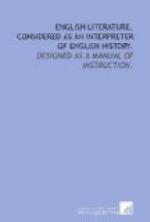THE WELSH TRIADS.—The next of the important Celtic remains is called The Welsh Triads, an early but progressive work of the Cymbric Celts. Some of the triads are of very early date, and others of a much later period. The work is said to have been compiled in its present form by Caradoc of Nantgarvan and Jevan Brecha, in the thirteenth century. It contains a record of “remarkable men and things which have been in the island of Britain, and of the events which befell the race of the Cymri from the age of ages,” i.e. from the beginning. It has also numerous moral proverbs. It is arranged in triads, or sets of three.
As an example, we have one triad giving “The three of the race of the island of Britain: Hu Gadarn, (who first brought the race into Britain;) Prydain, (who first established regal government,) and Dynwal Moelmud, (who made a system of laws.)” Another triad presents “The three benevolent tribes of Britain: the Cymri, (who came with Hu Gadarn from Constantinople;) the Lolegrwys, (who came from the Loire,) and the Britons”
Then are mentioned the tribes that came with consent and under protection, viz., the Caledonians, the Gwyddelian race, and the men of Galedin, who came from the continent “when their country was drowned;” the last inhabited the Isle of Wight. Another mentions the three usurping tribes; the Coranied, the Gwydel-Fichti, (from Denmark,) and the Saxons. Although the compilation is so modern, most of the triads date from the sixth century.
THE MABINOGION.—Next in order of importance of the Celtic remains must be mentioned the Mabinogion, or Tales for Youth, a series of romantic tales, illustrative of early British life, some of which have been translated from the Celtic into English. Among these the most elaborate is the Tale of Peredur, a regular Romance of Arthur, entirely Welsh in costume and character.
BRITISH BARDS.—A controversy has been fiercely carried on respecting the authenticity of poems ascribed to Aneurin, Taliesin, Llywarch Hen, and Merdhin, or Merlin, four famous British bards of the fifth and sixth centuries, who give us the original stories respecting Arthur, representing him not as a “miraculous character,” as the later histories do, but as a courageous warrior worthy of respect but not of wonder. The burden of the evidence, carefully collected and sifted by Sharon Turner,[5] seems to be in favor of the authenticity of these poems.
These works are fragmentary and legendary: they have given few elements to the English language, but they show us the condition and culture of the British mind in that period, and the nature of the people upon whom the Saxons imposed their yoke. “The general spirit [of the early British poetry] is much more Druidical than Christian,"[6] and in its mysterious and legendary nature, while it has been not without value as a historical representation of that early period, it has offered rare material for romantic poetry from that day to the present time. It is on this account especially that these works should be studied.




